Zhou Zhang
Knowledge-guided machine learning model with soil moisture for corn yield prediction under drought conditions
Mar 20, 2025Abstract:Remote sensing (RS) techniques, by enabling non-contact acquisition of extensive ground observations, have become a valuable tool for corn yield prediction. Traditional process-based (PB) models are limited by fixed input features and struggle to incorporate large volumes of RS data. In contrast, machine learning (ML) models are often criticized for being ``black boxes'' with limited interpretability. To address these limitations, we used Knowledge-Guided Machine Learning (KGML), which combined the strengths of both approaches and fully used RS data. However, previous KGML methods overlooked the crucial role of soil moisture in plant growth. To bridge this gap, we proposed the Knowledge-Guided Machine Learning with Soil Moisture (KGML-SM) framework, using soil moisture as an intermediate variable to emphasize its key role in plant development. Additionally, based on the prior knowledge that the model may overestimate under drought conditions, we designed a drought-aware loss function that penalizes predicted yield in drought-affected areas. Our experiments showed that the KGML-SM model outperformed other ML models. Finally, we explored the relationships between drought, soil moisture, and corn yield prediction, assessing the importance of various features and analyzing how soil moisture impacts corn yield predictions across different regions and time periods.
Unleashing the Power of Emojis in Texts via Self-supervised Graph Pre-Training
Sep 26, 2024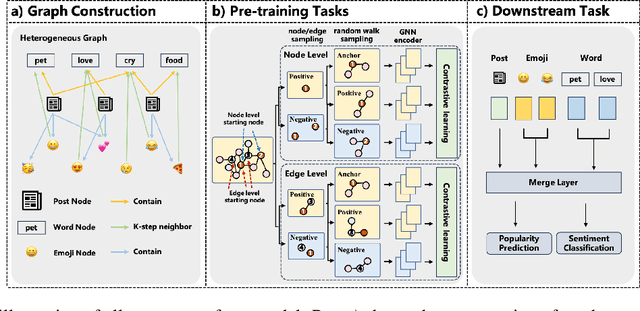
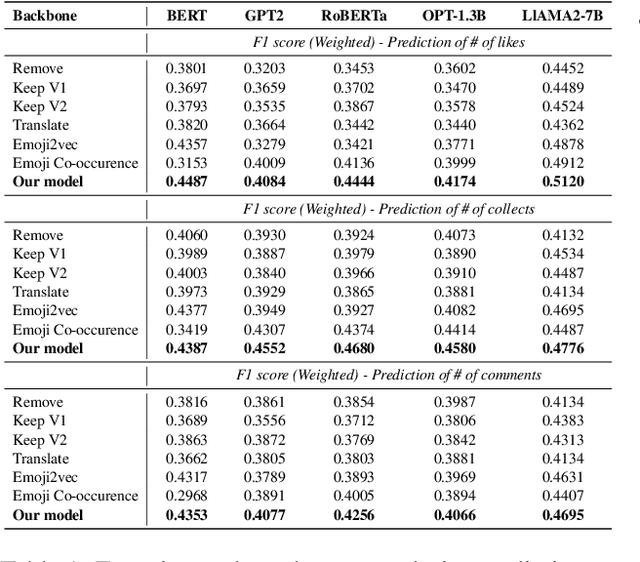
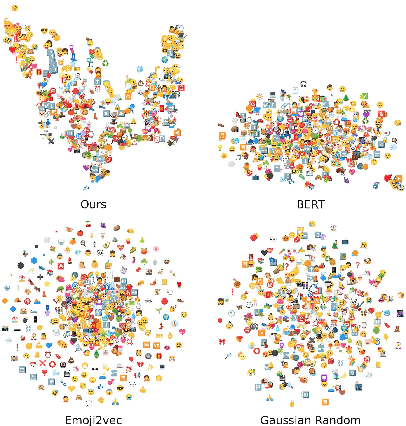
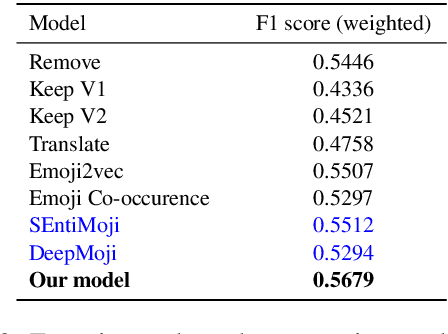
Abstract:Emojis have gained immense popularity on social platforms, serving as a common means to supplement or replace text. However, existing data mining approaches generally either completely ignore or simply treat emojis as ordinary Unicode characters, which may limit the model's ability to grasp the rich semantic information in emojis and the interaction between emojis and texts. Thus, it is necessary to release the emoji's power in social media data mining. To this end, we first construct a heterogeneous graph consisting of three types of nodes, i.e. post, word and emoji nodes to improve the representation of different elements in posts. The edges are also well-defined to model how these three elements interact with each other. To facilitate the sharing of information among post, word and emoji nodes, we propose a graph pre-train framework for text and emoji co-modeling, which contains two graph pre-training tasks: node-level graph contrastive learning and edge-level link reconstruction learning. Extensive experiments on the Xiaohongshu and Twitter datasets with two types of downstream tasks demonstrate that our approach proves significant improvement over previous strong baseline methods.
Throughput Optimization in Cache-aided Networks: An Opportunistic Probing and Scheduling Approach
Sep 02, 2024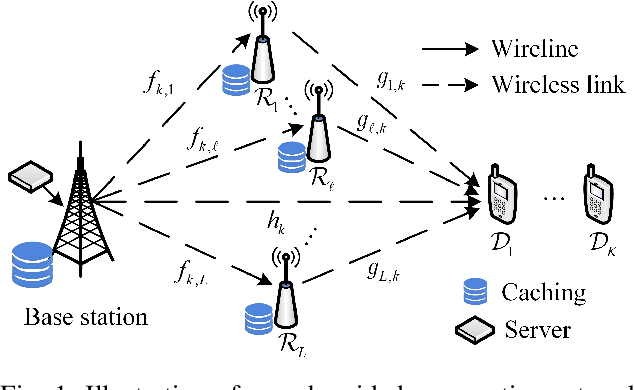
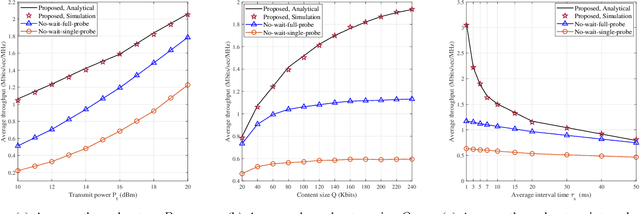
Abstract:This paper addresses the challenges of throughput optimization in wireless cache-aided cooperative networks. We propose an opportunistic cooperative probing and scheduling strategy for efficient content delivery. The strategy involves the base station probing the relaying channels and cache states of multiple cooperative nodes, thereby enabling opportunistic user scheduling for content delivery. Leveraging the theory of Sequentially Planned Decision (SPD) optimization, we dynamically formulate decisions on cooperative probing and stopping time. Our proposed Reward Expected Thresholds (RET)-based strategy optimizes opportunistic probing and scheduling. This approach significantly enhances system throughput by exploiting gains from local caching, cooperative transmission and time diversity. Simulations confirm the effectiveness and practicality of the proposed Media Access Control (MAC) strategy.
Dynamic Cooperative MAC Optimization in RSU-Enhanced VANETs: A Distributed Approach
Feb 14, 2024Abstract:This paper presents an optimization approach for cooperative Medium Access Control (MAC) techniques in Vehicular Ad Hoc Networks (VANETs) equipped with Roadside Unit (RSU) to enhance network throughput. Our method employs a distributed cooperative MAC scheme based on Carrier Sense Multiple Access with Collision Avoidance (CSMA/CA) protocol, featuring selective RSU probing and adaptive transmission. It utilizes a dual timescale channel access framework, with a ``large-scale'' phase accounting for gradual changes in vehicle locations and a ``small-scale'' phase adapting to rapid channel fluctuations. We propose the RSU Probing and Cooperative Access (RPCA) strategy, a two-stage approach based on dynamic inter-vehicle distances from the RSU. Using optimal sequential planned decision theory, we rigorously prove its optimality in maximizing average system throughput per large-scale phase. For practical implementation in VANETs, we develop a distributed MAC algorithm with periodic location updates. It adjusts thresholds based on inter-vehicle and vehicle-RSU distances during the large-scale phase and accesses channels following the RPCA strategy with updated thresholds during the small-scale phase. Simulation results confirm the effectiveness and efficiency of our algorithm.
Learning county from pixels: Corn yield prediction with attention-weighted multiple instance learning
Dec 02, 2023Abstract:Remote sensing technology has become a promising tool in yield prediction. Most prior work employs satellite imagery for county-level corn yield prediction by spatially aggregating all pixels within a county into a single value, potentially overlooking the detailed information and valuable insights offered by more granular data. To this end, this research examines each county at the pixel level and applies multiple instance learning to leverage detailed information within a county. In addition, our method addresses the "mixed pixel" issue caused by the inconsistent resolution between feature datasets and crop mask, which may introduce noise into the model and therefore hinder accurate yield prediction. Specifically, the attention mechanism is employed to automatically assign weights to different pixels, which can mitigate the influence of mixed pixels. The experimental results show that the developed model outperforms four other machine learning models over the past five years in the U.S. corn belt and demonstrates its best performance in 2022, achieving a coefficient of determination (R2) value of 0.84 and a root mean square error (RMSE) of 0.83. This paper demonstrates the advantages of our approach from both spatial and temporal perspectives. Furthermore, through an in-depth study of the relationship between mixed pixels and attention, it is verified that our approach can capture critical feature information while filtering out noise from mixed pixels.
Distributed CSMA/CA MAC Protocol for RIS-Assisted Networks
Sep 21, 2023Abstract:This paper focuses on achieving optimal multi-user channel access in distributed networks using a reconfigurable intelligent surface (RIS). The network includes wireless channels with direct links between users and RIS links connecting users to the RIS. To maximize average system throughput, an optimal channel access strategy is proposed, considering the trade-off between exploiting spatial diversity gain with RIS assistance and the overhead of channel probing. The paper proposes an optimal distributed Carrier Sense Multiple Access with Collision Avoidance (CSMA/CA) strategy with opportunistic RIS assistance, based on statistics theory of optimal sequential observation planned decision. Each source-destination pair makes decisions regarding the use of direct links and/or probing source-RIS-destination links. Channel access occurs in a distributed manner after successful channel contention. The optimality of the strategy is rigorously derived using multiple-level pure thresholds. A distributed algorithm, which achieves significantly lower online complexity at $O(1)$, is developed to implement the proposed strategy. Numerical simulations verify the theoretical results and demonstrate the superior performance compared to existing approaches.
Corn Yield Prediction based on Remotely Sensed Variables Using Variational Autoencoder and Multiple Instance Regression
Nov 23, 2022



Abstract:In the U.S., corn is the most produced crop and has been an essential part of the American diet. To meet the demand for supply chain management and regional food security, accurate and timely large-scale corn yield prediction is attracting more attention in precision agriculture. Recently, remote sensing technology and machine learning methods have been widely explored for crop yield prediction. Currently, most county-level yield prediction models use county-level mean variables for prediction, ignoring much detailed information. Moreover, inconsistent spatial resolution between crop area and satellite sensors results in mixed pixels, which may decrease the prediction accuracy. Only a few works have addressed the mixed pixels problem in large-scale crop yield prediction. To address the information loss and mixed pixels problem, we developed a variational autoencoder (VAE) based multiple instance regression (MIR) model for large-scaled corn yield prediction. We use all unlabeled data to train a VAE and the well-trained VAE for anomaly detection. As a preprocess method, anomaly detection can help MIR find a better representation of every bag than traditional MIR methods, thus better performing in large-scale corn yield prediction. Our experiments showed that variational autoencoder based multiple instance regression (VAEMIR) outperformed all baseline methods in large-scale corn yield prediction. Though a suitable meta parameter is required, VAEMIR shows excellent potential in feature learning and extraction for large-scale corn yield prediction.
Reconstructing normal section profiles of 3D revolving structures via pose-unconstrained multi-line structured-light vision
Apr 27, 2020



Abstract:The wheel of the train is a 3D revolving geometrical structure. Reconstructing the normal section profile is an effective approach to determine the critical geometric parameter and wear of the wheel in the community of railway safety. The existing reconstruction methods typically require a sensor working in a constrained position and pose, suffering poor flexibility and limited viewangle. This paper proposes a pose-unconstrained normal section profile reconstruction framework for 3D revolving structures via multiple 3D general section profiles acquired by a multi-line structured light vision sensor. First, we establish a model to estimate the axis of 3D revolving geometrical structure and the normal section profile using corresponding points. Then, we embed the model into an iterative algorithm to optimize the corresponding points and finally reconstruct the accurate normal section profile. We conducted real experiment on reconstructing the normal section profile of a 3D wheel. The results demonstrate that our algorithm reaches the mean precision of 0.068mm and good repeatability with the STD of 0.007mm. It is also robust to varying pose variations of the sensor. Our proposed framework and models are generalized to any 3D wheeltype revolving components.
 Add to Chrome
Add to Chrome Add to Firefox
Add to Firefox Add to Edge
Add to Edge